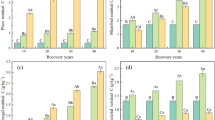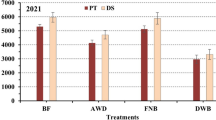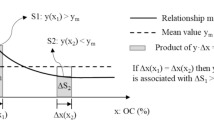Abstract
Continuous practices of cereal–cereal rotations in Indo-Gangetic plain (IGP) region have emerged with several soil related issues including depletion of soil organic carbon (SOC). Crop diversification remains a conceivable option to address this issue. Here, the authors envisaged the long-term alternate-year inclusion of chickpea in upland maize–wheat and lowland rice–wheat systems on SOC, C-dynamics and C management indices under organic, inorganic, and control nutrient management. Inclusion of chickpea in rice–wheat and maize–wheat systems increased total organic C (TOC) by 6.5 and 13.4%, and particulate organic C (POC) by 94.7 and 41.3% in the surface soil (0–0.2 m), respectively. In both the production systems, enrichment of very-labile C (Cfrac1) and labile C (Cfrac2) fractions were apparent with inclusion of chickpea. Very-labile (Cfrac1) (36.6–37.9%) in upland and less-labile (Cfrac3) (29.1–31.7%) in lowland were the dominant C-fractions. Subsequently, upland conditions had higher active C-pool; conversely, lowland ecosystem enriched passive C-pool, which is desirable for long-term persistence of soil C. The higher values of TOC, POC, and C-fractions were registered in organic nutrient treatment over inorganic and control treatment. In lowland, chickpea residue C had a low rate of stabilization as compared to cereal residue. In lowland, crop diversification with chickpea increased lability-index and C-management index; however, the effect was marginal in upland. Thus, inclusion of chickpea in the cereal–cereal rotations of IGP would be a potential long-term strategy to improve SOC and to ensure production sustainability.





Similar content being viewed by others
References
Jat ML, Gathala MK, Ladha JK, Saharawat YS, Jat AS, Sharma SK, Kumar V, Gupta RK (2009) Evaluation of precision land leveling and double zero-till systems in the rice–wheat rotation: water use, productivity, profitability and soil physical properties. Soil Tillage Res 105:112–121
Bhattacharyya R, Das TK, Sudhishri S, Dudwal B, Sharma AR, Bhatia A, Singh G (2015) Conservation agriculture effects on soil organic carbon accumulation and crop productivity under a rice–wheat cropping system in the western Indo-Gangetic Plains. Eur J Agron 70:11–21
Chauhan BS, Mahajan G, Sardana V, Timsina J, Jat ML (2012) Productivity and sustainability of the rice–wheat cropping system in the Indo-Gangetic Plains of the Indian subcontinent: problems, opportunities, and strategies. Adv Agron 117:315–369
Venkatesh MS, Hazra KK, Ghosh PK, Praharaj CS, Kumar N (2013) Long-term effect of pulses and nutrient management on soil carbon sequestration in Indo-Gangetic plains of India. Can J Soil Sci 93:127–136
Ganeshamurthy AN (2009) Soil changes following long-term cultivation of pulses. J Agric Sci 147:699–706
Rogasik J, Schroetter S, Funde U, Schnug E, Kurtineez P (2004) Long-term fertilizer experiment as a database for calculating carbon sink potential of arable soils. Arch Agron Soil Sci 50:11–19
Mandal B, Majumder B, Bandyopadhyay PK, Hazra GC, Gangopadhyay A, Samantaray RN, Mishra AK, Chaudhury J, Saha MN, Kundu S (2007) The potential of cropping systems and soil amendments for carbon sequestration in soils under long-term experiments in subtropical India. Glob Change Biol 13:357–369
Freixo AA, Machado PL, Santos HP (2002) Soil organic carbon and fractions of a Rhodic Ferralsol under the influence of tillage and crop rotation systems in southern Brazil. Soil Tillage Res 64:221–230
Chan KY, Heenan DP, Oates A (2002) Soil carbon fractions and relationship to soil quality under different tillage and stubble management. Soil Tillage Res 63:133–139
Majumder B, Mandal B, Bandyopadhyay PK, Chaudhury J (2007) Soil organic carbon pools and productivity relationships for a 34 year old rice–wheat–jute agro-ecosystem under different fertilizer treatments. Plant Soil 297:53–67
Srinivasarao C, Venkateswarlu B, Lal R, Singh AK, Kundu S, Vittal KPR, Balaguravaiah G, Chary R, Prasadbabu MBB (2012) Soil carbon sequestration and agronomic productivity of an Alfisol for a groundnut-based system in a semiarid environment in southern India. Eur J Agron 43:40–48
Walkley A, Black IA (1934) An examination of method for determining organic carbon in soils: effect of variations in digestion conditions and of inorganic soil constituents. Soil Sci 63:251–263
Hesse PR (2002) A text book of soil chemical analysis. CBS Publishers and Distributors, New Delhi
Chan KY, Bowman A, Oates A (2001) Oxidizible organic carbon fractions and soil quality changes in oxic paleustalf under different pasture leys. Soil Sci 166:61–67
Ghosh S, Wilson BR, Mandal B, Ghoshal SK, Growns I (2010) Changes in soil organic carbon pool in three long-term fertility experiments with different cropping systems and inorganic and organic soil amendments in the eastern cereal belt of India. Aust J Soil Res 48:413–420
Nelson DW, Sommers LE (1982) Total carbon, organic carbon, and organic matter. In: Page AL (ed) Methods of soil analysis, 2nd edn. ASA Monograph 9(2). American Society of Agronomy, Madison, pp 539–579
Blair GJ, Lefroy RDB, Lisle L (1995) Soil carbon fractions based on their degree of oxidation and development of a carbon management index for agricultural systems. Aust J Agric Res 46:1459–1466
Sollins P, Glassman C, Paul EA, Swanston C, Lajtha K, Heil JW, Elliott ET (1999) Soil carbon and nitrogen: pools and fractions. In: Robertson GP et al (eds) standard soil methods for long-term ecological research. Oxford University Press Inc, New York, pp 89–105
Cadish G, de Oliveira OC, Cantarutti R, Carvalho E, Urquiaga S, Bergstrom L, Kirchmann H (1998) The role of legume quality in soil carbon dynamics in savannah ecosystems. In: Bergerström L, Kirchmann H (eds) Carbon and nutrient dynamics in natural and agricultural tropical ecosystems, CAB International, Wallingford, Oxford, UK, pp 47–70
Nayak AK, Gangwar B, Shukla AK, Mazumdar SP, Kumar A, Raja R, Kumar A, Kumar V, Rai PK, Mohan U (2012) Long-term effect of different integrated nutrient management on soil organic carbon and its fractions and sustainability of rice–wheat system in Indo Gangetic Plains of India. Field Crop Res 127:129–139
Kaur T, Brar BS, Dhillon NS (2008) Soil organic matter dynamics as affected by long-term use of organic and inorganic fertilizers under maize–wheat cropping system. Nut Cycl Agroecosyst 81:59–69
Lefroy RDB, Blair GJ, Strong WM (1994) Changes in soil organic matter with cropping as measured by organic carbon fractions and 13C natural isotope abundance. Plant Soil 155(156):399–402
Benbi DK, Toor AS, Kumar S (2012) Management of organic amendments in rice–wheat cropping system determines the pool where carbon is sequestered. Plant Soil 360:145–162
Majumder B, Mandal B, Bandyopadhyay PK (2008) Soil organic carbon pools and productivity in relation to nutrient management in a 20-year-old rice–berseem agroecosystem. Biol Fertil Soil 44:451–461
Jenkinson DS (1988) Determination of microbial biomass carbon and nitrogen in soil. In: Wilson JR (ed) Advances in nitrogen cycling in agricultural ecosystems. CAB International, Wallingford, pp 368–386
Singh Y, Singh B, Timsina J (2005) Crop residue management for nutrient cycling and improving soil productivity in rice-based cropping systems in the tropics. Adv Agron 85:269–407
Ghosh BN, Meena VS, Alam NM, Dogra P, Bhattacharyya R, Sharma NK, Mishra PK (2016) Impact of conservation practices on soil aggregation and the carbon management index after seven years of maize–wheat cropping system in the Indian Himalayas. Agric Ecosyst Environ 216:247–257
Tirol-Padre A, Ladha JK (2004) Assessing the reliability of permanganate-oxidizable carbon as an index of soil labile carbon. Soil Sci Soc Am J 68:969–978
Vieira FCB, Bayer C, Zanatta JA, Dieckow J, Mielniczuk J, He ZL (2007) Carbon management index based on physical fractionation of soil organic matter in an Acrisol under long-term no-till cropping systems. Soil Tillage Res 96:195–204
Acknowledgements
The research work was funded by ICAR–Indian Institute of Pluses Research, Kanpur, India.
Author information
Authors and Affiliations
Corresponding author
Ethics declarations
Conflict of interest
The authors declare that they have no conflict of interest.
Additional information
Significance Statement
Authors recommend that crop diversification with pulse crop can improve soil organic carbon pools in long-run. Alternate-year inclusion of chickpea in rice–wheat and maize–wheat rotation improved the soil organic carbon pools and sustained crop productivity.
Rights and permissions
About this article
Cite this article
Ghosh, P.K., Hazra, K.K., Venkatesh, M.S. et al. Increasing Soil Organic Carbon Through Crop Diversification in Cereal–Cereal Rotations of Indo-Gangetic Plain. Proc. Natl. Acad. Sci., India, Sect. B Biol. Sci. 89, 429–440 (2019). https://doi.org/10.1007/s40011-017-0953-x
Received:
Revised:
Accepted:
Published:
Issue Date:
DOI: https://doi.org/10.1007/s40011-017-0953-x




